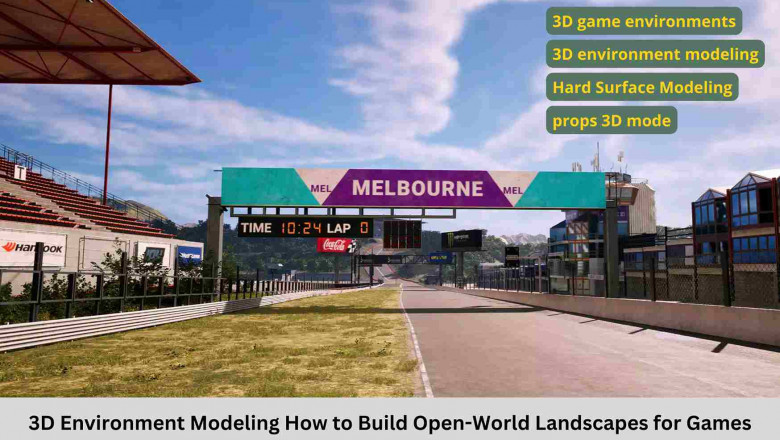views
In the world of modern gaming, open-world landscapes are crucial to creating immersive and expansive game environments. 3D environment modeling plays a pivotal role in building detailed worlds that captivate players and enhance gameplay experiences. Whether you are designing a vast wilderness, a futuristic cityscape, or a post-apocalyptic wasteland, mastering 3D modeling games requires strategic planning, the right tools, and an understanding of various modeling techniques. This guide will walk you through the essential steps of building open-world landscapes and explain the key aspects of crafting 3D game environments.
Understanding the Foundations of 3D Environment Modeling
3D environment modeling involves designing and sculpting landscapes, terrains, and structures that make up the game world. The complexity of these environments varies depending on the game genre and the level of realism desired. Before diving into the modeling process, consider the following factors:
- Game Engine Compatibility – Ensure that your models are optimized for game engines like Unreal Engine or Unity.
- Art Style and Theme – Define the visual style, whether realistic, stylized, or semi-realistic.
- Performance Optimization – Balance detail and polygon count to maintain performance.
Steps to Building an Open-World Landscape
1. Conceptualizing the Environment
Before starting the 3D modeling process, it is essential to develop a clear vision of the game world. Concept art, mood boards, and real-world references help establish the look and feel of the environment. Identify the main elements such as terrain types, vegetation, buildings, and props 3D models that will populate the landscape.
2. Creating the Terrain
The foundation of any open-world game environment is the terrain. Here’s how to approach terrain creation:
- Heightmaps & Procedural Generation – Use heightmaps to generate realistic topography or procedural tools in software like World Machine, Gaea, or Houdini to create natural-looking landscapes.
- Sculpting & Texturing – Manually refine the terrain using sculpting tools in Blender, ZBrush, or within the game engine itself.
- Material Blending – Apply textures for rock, grass, dirt, and water with procedural shaders for seamless blending.
3. Adding 3D Game Assets and Props
Once the terrain is established, the next step is to populate the world with 3D game assets:
- Rocks, Trees, and Foliage – Use SpeedTree or hand-modeled trees and vegetation to add realism.
- Buildings and Structures – Employ modular 3D hard surface modeling techniques to create cities, villages, or ruins efficiently.
- Props and Small Details – Scatter props 3D models like barrels, fences, and furniture to enhance immersion.
4. Implementing 3D Vehicles and Transportation Elements
Vehicles are an essential part of open-world games, whether for transportation or decoration:
- Car 3D Models – Design realistic or stylized vehicles using software like Maya or Blender.
- 3D Vehicle Modeling – Focus on topology, details, and optimized textures for smooth performance.
- Interactive Elements – Ensure vehicles are animated and physics-based if they are part of gameplay.
5. Lighting and Atmosphere
Lighting is key to setting the mood and making environments feel alive:
- Dynamic and Static Lighting – Use a mix of real-time lighting and baked lighting to achieve optimal performance.
- Volumetric Effects – Add fog, mist, and god rays to create depth and realism.
- Day-Night Cycle – Implement dynamic time-of-day systems for more immersive environments.
6. Optimization for Performance
Large open-world environments require careful optimization to ensure smooth gameplay. Here’s how:
- Level of Detail (LOD) Models – Use LOD techniques to reduce polygon count for distant objects.
- Efficient Texturing – Utilize texture atlases and trim sheets to minimize draw calls.
- Occlusion Culling & Streaming – Implement techniques that load only the visible parts of the world to improve FPS.
Tools and Software for 3D Environment Modeling
To create high-quality 3D game environments, you need the right tools:
- Blender & Autodesk Maya – For modeling, sculpting, and animation.
- ZBrush – Ideal for high-detail sculpting.
- Substance Painter & Designer – For realistic texture painting.
- Unreal Engine & Unity – Game engines for assembling and testing environments.
- World Machine & Gaea – For procedural terrain generation.
Final Thoughts
Building an open-world landscape for games requires a combination of artistic skills, technical knowledge, and optimization strategies. Whether you're working on 3D environment modeling for AAA titles or indie projects, mastering the fundamentals of 3D game assets, 3D game environments, and hard surface modeling will help you create stunning and immersive game worlds. By integrating detailed props, realistic terrain, and well-optimized 3D models, you can craft an unforgettable gaming experience that captivates players and enhances storytelling.






















Comments
0 comment